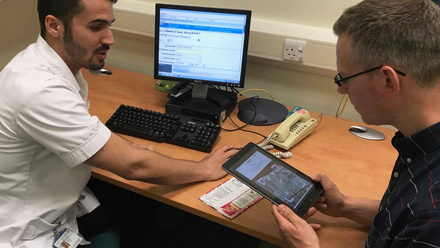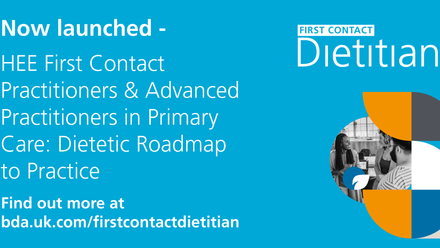An ageing population and increase in long-term conditions has led to high demands in primary care.
Several important health service documents have defined the challenges facing the health service and general practice, and proposed solutions. The NHS Long Term Plan(1 - see references below) places primary care at the centre; looking at doing things differently, taking more action on preventative measures, and improving care quality and outcomes for major conditions. The General Practice Forward View2 advises making better use of the wider primary care workforce to reduce demand on GP time and the updated GP contract3 has added dietitians to the additional roles reimbursement scheme.
A shift from established methods
There is now a shift away from long-established methods of working, such as the GP as the first point of contact for patients, and a move towards expanding the multidisciplinary team (MDT) and drawing on the skills of other health care professionals.4 Dietitians have an important part to play in this and now need to demonstrate what they can contribute to primary care.
The BDA and Health Education England jointly funded a project to look at dietetic-led care in general practice. Three models of care were evaluated. The first model evaluated the benefits of a dietitian working as a first contact practitioner to manage frailty and malnutrition. A dietitian was employed in a primary care network (PCN) six hours per week for six months. SystmOne health informatics was used to screen for patients ≥65 years at risk of frailty or low weight and patients were triaged by the dietitian using the Patients Association Nutrition Checklist, a nutrition screening tool recently validated against MUST.5
Of the 186 patients triaged by the dietitian, 142 (75%) were found to be at risk of malnutrition. During the six months, 63 patients were provided with a dietetic consultation and follow up. Following this intervention patients improved their BMI, strength, frailty and nutrition scores, which potentially improved their ability to mobilise and exercise, reducing the risk of falls and secondary care admissions. Oral nutritional supplement (ONS) prescription changes instigated by the dietitian, in only 27 patients, equated to projected total annual cost savings of £15,379. This illustrates the value of dietitians as first contact practitioners within the MDT in primary care for the care of older frail people at risk of malnutrition.
The second model evaluated the benefits of a dietitian working as an expert generalist within a general practice MDT. A dietitian was employed in a PCN three days a week for six months, treating and advising patients with a wide range of diagnoses, both paediatric and adult, and was considered an integral member of the MDT.
Data were collected from the MDT, by holding a focus group, to understand the added value of the dietitian. A range of professionals within the PCN referred patients with multiple long-term conditions to the dietitian. The dietitian played a large role in the care of patients with diabetes, contributing to education through training staff, as well as seeing complex patients. The dietitian had influence through her presence in the practice, and engagement with the rest of the practice team, where her support and expertise enhanced referral processes and patient satisfaction. The pharmacist recognised that prescribing patterns were changing. Where there had been a cascade of medicines prescribed, this had reduced, potentially saving money. In this model of care not only were clinical and financial outcomes achieved, but also support and education was provided for the team.
In the last model, we evaluated the benefits of a dietetic-led paediatric food allergy service. This involved the comparison of the new service model with a standard service model in terms of cost, service efficiency, acceptability and clinical outcome. In the new service model the children’s public health nursing team were provided with training to recognise potential cases of food allergy and to undertake basic diagnostic assessment, before referral to the dietitian. The child’s condition could then be managed by the dietitian, with little direct contact with their GP. This meant the dietitians were working at an advanced level, including an active role in the medicine management of allergy-related symptoms, requiring achievement of new competencies. This model of care led to fewer appointments with the GP and consultants prior to seeing the dietitian, suggesting significant costs savings may be gained.
These models of care illustrate some of the ways in which dietitians can support high-quality, patient-centred care in the primary care setting, offering a valuable and cost effective resource to general practice.
References
- NHS ENGLAND (2019) The NHS Long Term Plan – a summary. London, NHS.
- NHS ENGLAND & ROYAL COLLEGE OF GENERAL PRACTITIONERS (2016) General Practice Forward View. London, NHS England.
- Primary Care Strategy and NHS Contracts Group. Update to the GP contract agreement 2020/21- 2023/24. NHS England: British Medical Association; 2020.
- Beech J et al. Closing the gap: key areas for action on the health and care workforce. Health Foundation; 2019.
- Murphy et al. (2020) Identifying older people at risk of malnutrition and treatment in the community: prevalence and concurrent validation of the Patients Association Nutrition Checklist with ‘MUST’. J Hum Nutr Diet, 33, 31-37.






